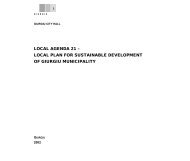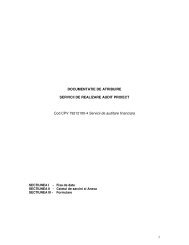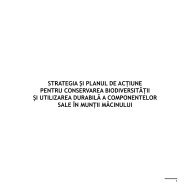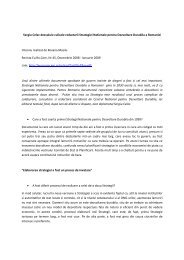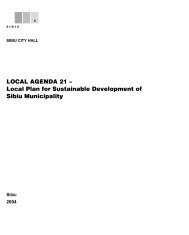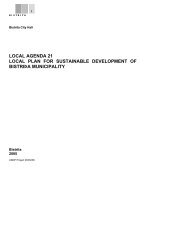English Version - United Nations Development Programme Romania
English Version - United Nations Development Programme Romania
English Version - United Nations Development Programme Romania
Create successful ePaper yourself
Turn your PDF publications into a flip-book with our unique Google optimized e-Paper software.
5.9%; machinery and equipment industry 10.7%; automotive industry: 7.2%; construction materials,<br />
glass and ceramics industries: 4.4%; metal products and metal constructions industry: 3.8%; electric<br />
and optical equipment industry: 3.9%.<br />
The structure of the workforce according to age groups (1996) is better balanced in industry than in<br />
other sectors of the economy and creates the necessary conditions for the sustainable development of<br />
industry. 90% of workers employed in industry are under 50 years of age, and 42,2% of workers are<br />
under 35 years of age.<br />
The specific problems that should be taken into account in designing the strategy for a sustainable<br />
development of the industry refer to the creation and application of a professional and managerial<br />
training system, in line with the global technical and technological progress. This strategy should also<br />
rehabilitate the activity of scientific research, stop the emigration of highly qualified specialists, and<br />
offer new opportunities to the unemployed, especially in the development and specialisation of<br />
services.<br />
d) Competitiveness of <strong>Romania</strong>'s industry<br />
The increasing decline of production and the low occupancy rate of the production potential<br />
demonstrate the decline in competitiveness in most energy intensive sectors that also require costly<br />
materials and capitals.<br />
As a result of foreign capital investment, privatisation, and certain technological improvements,<br />
the following industries have had a relatively satisfactory growth: the communications equipment<br />
industry, the automotive industry, as well as industries manufacturing electric equipment, textile,<br />
clothing, construction materials, furniture, tyres, antibiotics, and chloride and sodium products.<br />
The shrinkage of the industrial production has been determined mainly by the slow adaptation to<br />
the new demands and structure of the markets after 1989, managerial incompetence at the<br />
microeconomic level (technical, financial, commercial, human resources) especially in state-owned<br />
enterprises.<br />
Other factors were: the increasing loss of capital and the dull economic environment, the slow<br />
pace of privatisation and restructuring, the incoherent and unstable legal framework which<br />
discouraged foreign investment, the insufficient support offered by the banking system to the reform<br />
process and also, the inability to use the opportunities created by the Association Agreement to the<br />
E.U. (technical and financial assistance, the asymmetric tariffs regime, safeguarding clauses, etc.).<br />
e) Privatisation<br />
The development of the private sector in industry was slower than that of other economic<br />
branches. In 1997, the industry's contribution to the net added value in the private sector of the economy<br />
reached 25.9%; this exceeds the contribution of the private sector in business.<br />
The private sector prevails in manufacturing varnish and paint (85%), cosmetics (93%),<br />
detergents (74%), meat products (67%), cooking oil (63%), bread (75%), beer and wine (over 60%),<br />
household glassware (86%), china (79%), newspaper editing and printing (94% and 75%, respectively),<br />
tyre, clothing, automated telephone exchange equipment (over 50%) etc.<br />
Fields where the private sector has a significant contribution with tendencies to increase:<br />
leather and footwear industry, wood processing, cement and construction materials industry,<br />
pharmaceuticals, chemical fertilisers and automobile industry etc.<br />
The contribution of the private sector is very low in sectors requiring large investment: the<br />
extractive industry, the generation of electric and thermal power, metallurgy, refineries and petroleum<br />
industry, manufacturing of machinery and equipment, cellulose and paper, etc.<br />
It is noteworthy that in the private industrial sector productivity is clearly superior to that in<br />
state-owned enterprises.<br />
This is demonstrated by the fact that 29.7% of the total population employed in the private sector<br />
produced in 1997 over 43% of the net added value. This is the result of a more efficient microeconomic<br />
management, of a more active investment policy and of amortisation of the fixed capital.<br />
OBJECTIVES AND DIRECTIONS FOR ACTION<br />
The deterioration of the industrial and economic activity, a situation that was first seen in the<br />
1980s, then the accelerated decline and chronic macroeconomic imbalance created between 1990 and<br />
1998, demonstrated that in the general context of the difficulties generated by the transition process, the<br />
socio-economic evolution of <strong>Romania</strong> was also adversely affected by the absence of an integrated global<br />
strategy capable to define a pragmatic approach to the medium- and long-term options and goals to be<br />
realised in the development of the main industrial branches and to evaluate and optimise the impact upon<br />
the human development.<br />
46






